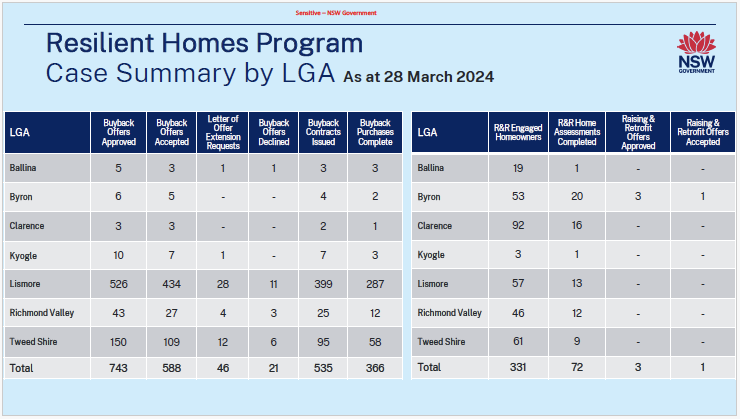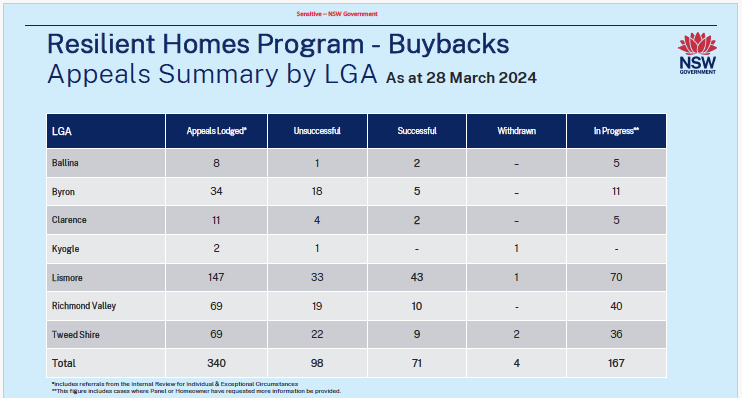Flood Mapping Independent Peer Review report is released with 25 recommendations
Simon Mumford
01 April 2024, 7:01 PM

Last week, the long-awaited Independent Peer Review Report that looked into the flood mapping used for house buybacks, house raisings and retrofits was released.
Steven Molino (Director, Water Technology Pty Ltd and chair), Andrew Gissing, Chief Executive Office, Natural Hazards Research Australia and Professor Seth Westra (Director, University of Adelaide Water Research Centre) were the people charged with looking at how Rhelm, a specialist consultancy with expertise in floodplain management and economics, used best practice data and the results used in the process were fair and reasonable.
The report listed 25 specific recommendations to:
- The property eligibility and prioritisation methodology
- The Resilient Homes Program (RHP) prioritisation approach
- Program implementation
One of the key points was making a house buyback decision based purely on flood mapping rather than including subtleties such as the age of a resident, the possible escape routes when a flood hits the region and the number of houses that will be left in a street once buybacks have been accepted.
The Lismore App sat down with Member for Lismore and Parliamentary Secretary for Disaster Recovery Janelle Saffin to get her thoughts on this key report. None of the 25 recommendations surprised her.
"I welcome the Independent Peer Review. In fact, the community leaders called for this because we weren't satisfied with the flood mapping that was presented to us and the way it would be implemented. We had real concerns about the implementation and the approach. We saw areas that we, locally, deemed to be high flood risk, and not in that category then we saw other areas that we thought weren't as high flood risk eligible at first base."
"When the Resilient Homes Program (RHP) started, which we welcomed, it had missing elements like a policy framework and a lack of comparative best practice examples, where it had been done before. There was no cultural planning, so we didn't end up with a street or two streets backing each other with four houses on a block where three houses get offered a buyback and the other one doesn't. There was no door-to-door approach, there was insufficient flood data and there was the issue of not including rural properties."
"All of these issues have now been addressed including the vulnerability factor as well. These are the people who were elderly, frail, disabled and some people were just absolutely terrified and could not go back to their home because of what happened on the 28th of February 2022, which we well know."
"So all of these elements have been included since the Resilient Homes Program has been rolled out, that's happened in an ad hoc way. It's now more policy-focused. I did meet the chair of the author of this review, a few of us did, and I said to him, you've told us what we knew colloquially as laypeople but you've done it with expertise and put it in writing.
"All of the recommendations, 25 of them, will be implemented, and some of them already have been so quite a lot of them have been implemented."
COMMUNICATION
Communication has been an ongoing issue for the NRRC and now the NSWRA. A number of the Peer Review Report recommendations were about improved communications. The term "a fuller explanation..." was used a lot and the reference was that the organisation omitted explanations because it may need to defend its key decisions to the people in the Northern Rivers. Will this change?
"I can see that changing because, as community leaders, we said, originally to the NRRC then the RA, if we have to explain the Resilient Homes Program in lay language to everybody, how do we do it? And that was never clear. The Peer Review Panel make it clear that everything that's done should be explainable, and defendable. So, yes, I do see it changing now. The approach has always been very much on communications, which is a whole different ballgame from Sydney, we need public information and regular information and we're just starting to see it slowly kicking in."
"I spoke to a woman today and she doesn't understand why she didn't get a buyback and then others did in the street. And I've said to her, email me and I'll get you at least looked at properly and explanations made to you.
RHP CRITERIA
A key recommendation of the Peer Review Report was to add further criteria when considering house buybacks, like being elderly and having an escape route even if you have a raised house. Will this see more house buybacks?
"There will be a few more but I don't think it'll be a lot more but there will be more based on that criteria which has already been added as we've been going along."
"We asked for this report last year, it was probably around June when we asked for it. In the interim, that criteria has been added. So the things they're recommending the escape route, the vulnerable, the frail, it already exists, it's in there. We had already bought in the appeals process and the 'exceptional circumstances', so it's already there and they will continue to work their way through it."
RAISED HOUSES STILL AT RISK
The Peer Review Report said that residents living in raised houses could still be considered at risk because of the lack of escape routes. It mentioned that most people are killed during flood events when they attempt to walk in flood waters. Ms Saffin mentioned the lack of warning from the Bureau of Meteorology and the SES was an important factor.
"The missing element was the lack of warning. Evacuation routes were certainly cut off, but that was due to the lack of warning and that's been documented in the O'Kane/Fuller Flood Inquiry report about the high-level failure of SES, not the locals."
"It is changing. I saw it in operation at Christmas time when we had the two potential flood events. There was the BOM giving updates every day, I sat in those, but the SES were going out earlier and saying this could happen, that could happen. That's what we asked for. So I saw them actually do it over that Christmas period."
"I remember how everybody always talked about there being a delay with the BOM warnings. The BOM says this but we've got the SES all here, we can see the water, we can see how fast it's coming and give people that early warning."
"The SES always felt constrained. And if it turns out to be a false alarm, it is better than what happened on the 28th of February 2022. I have told the SES, I will defend you if you do it early and it turns out to be a false alarm. But we still do need to do a lot of work I think statewide in that whole area."
LOWERING THE COST OF AFTER THE NEXT NATURAL DISASTER
While the purpose of the RHP and the Resilient Land Program is to lower the risk to life when the next major flood hits Lismore, the other component is that this will lower the cost to the government. Australia's most costly natural disaster was estimated at $5.7 billion in terms of insurance losses. House retrofits is another way to build back better and keep future costs lower.
"That's what they've done in Queensland. There's a whole lot of people who if they don't do a retrofit or a buyback, they would virtually all have to move and that's not going to happen everywhere. There will be retreats over time. I saw a unit in the Valley in Brisbane where one flood put the owners out for weeks and weeks, then with a retrofit after the next flood, it was like a day and a half. So it can be done and that's why the RA has hired James Davidson Architect, JDA because they're actually the ones working on this program here now."
"We are trying to change what I call the 97/3. 97% we spend on recovery and 3% on mitigation and adaptation. But that's going to take decades, realistically in my view, because not much has been done."
It was recognised that local flood mapping data was not the most detailed it could and probably should be for a high flood area like Lismore and the Northern Rivers. Cost being the largest obstacle but it was considered to be 'best practice' from the available data. The CSIRO full Richmond Catchment Flood Report will lay those concerns to rest when it is released in 2025 as each of the local councils can use that data to run specific flood mapping for its own LGA.
This is when the RHP will have to be revisited and improved once again.
"I could say this process has been a bloody mess, and I have so I'm on the record, but the other sense is we've made headway for the rest of NSW when there wasn't a lot done in this space at all. The Central West say they have learnt from our mistakes."
"What I see coming out of this is the Northern Rivers getting one of the first Disaster Adaptation Plans. This is legislated, so each area across NSW has to have a Disaster Adaptation Plan."
The latest RHP statistics were released last week and are below.



